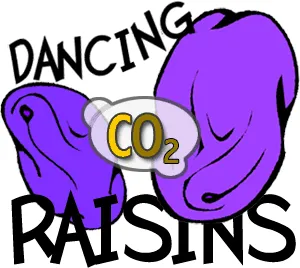 The Teacher's Corner
The Teacher's Corner
Carbon Dioxide Science Experiment
Dancing Raisins
This week's experiment is another old classic which is still a lot of fun. Now that I think of it, it seems that most of the science tricks I did as a kid have become OLD classics.
You will need:
- a glass
- raisins
- clear carbonated soda
 Pour some soda into the glass. We want to be sure that it has plenty of fizz left in it, so take a big swallow. Is it fizzy enough? Maybe another swallow, just to be sure. OK, now fill the glass back up with soda and get out the raisins. You had better eat a few of them too, just to be sure they are OK. Now you know one of the reasons I like science so much. Drop a few raisins into the soda. They sink to the bottom. Wow, that was exciting! But wait! Watch for few seconds and you should see something happen.
Pour some soda into the glass. We want to be sure that it has plenty of fizz left in it, so take a big swallow. Is it fizzy enough? Maybe another swallow, just to be sure. OK, now fill the glass back up with soda and get out the raisins. You had better eat a few of them too, just to be sure they are OK. Now you know one of the reasons I like science so much. Drop a few raisins into the soda. They sink to the bottom. Wow, that was exciting! But wait! Watch for few seconds and you should see something happen.
Some of the raisins suddenly float upwards through the soda. When they reach the top, they sink again. Soon, the raisins are dancing up and down in the glass. What is going on? Watch carefully and you should be able to figure it out.
Did you see what is happening? Tiny bubbles from the soda are forming on the raisins. When a raisin gets enough bubbles on it, it rises to the top. Where are the bubbles coming from? Right! They are coming from the soda. The fizz in the soda is a gas called carbon dioxide. There is so much carbon dioxide dissolved in the soda that it does not take much to cause it to come out. One way to do this is with a small bubble. The surface of the raisin traps tiny bubbles of air when you drop then into the glass. These tiny bubbles collect carbon dioxide from the soda and begin to grow. When the bubbles grow large enough, they lift the raisin. As they reach the top, the bubbles pop and the raisin sinks again. While most of the gas goes into the air, a small amount of the carbon dioxide sticks to the surface of the raisin and it starts all over again.
I have seen this experiment done with uncooked macaroni, but I find that raisins collect more bubbles and they are a lot more fun to eat. You might try different kinds of soda. Soda with more fizz will cause the raisins to react more.
 See our other Science Experiments
See our other Science Experiments
All lessons are brought to you by The Teacher's Corner and Robert Krampf's Science Education Company.
Robert Krampf's Science Shows thehappyscientist.com